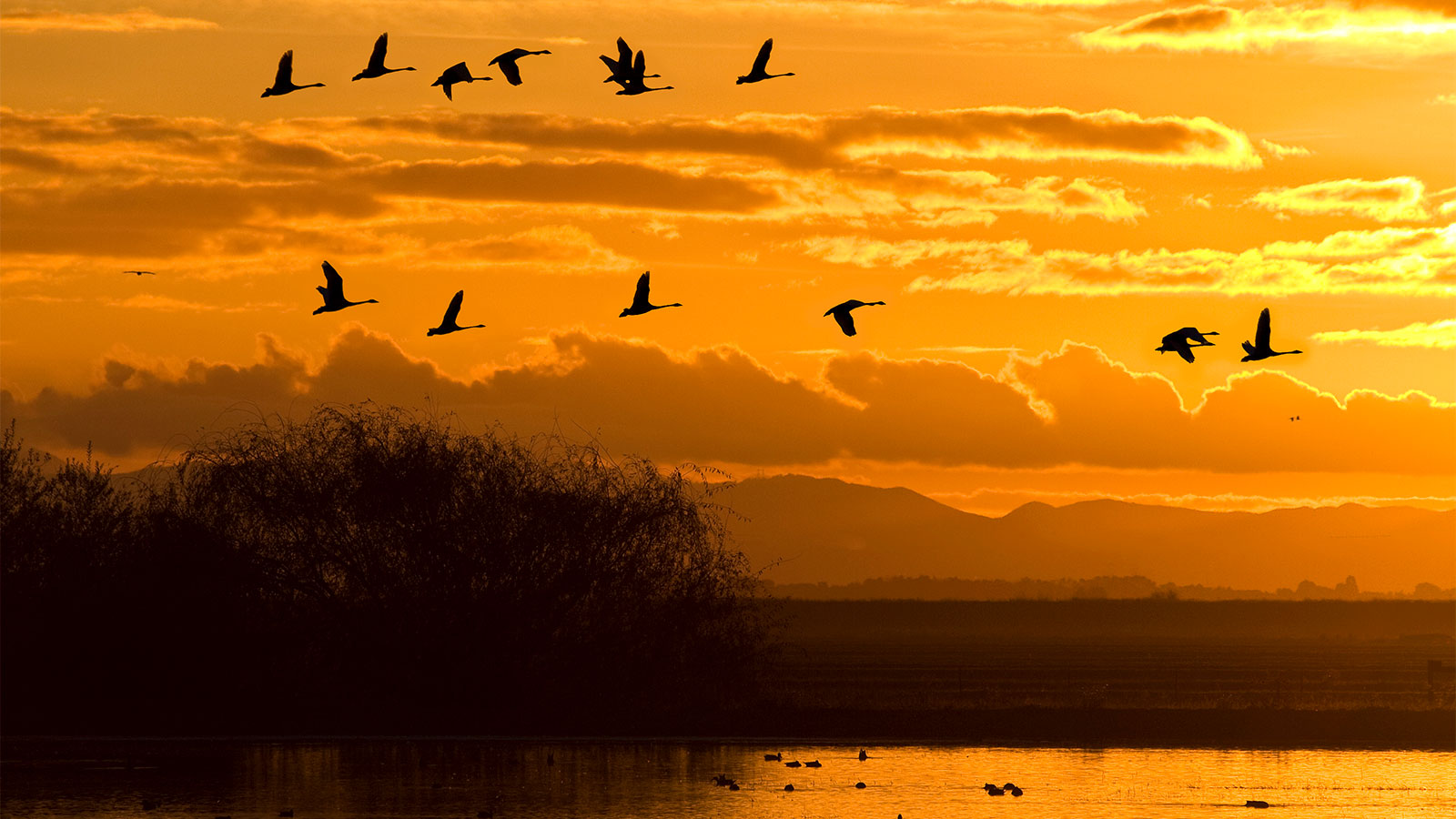From the air, California’s Central Valley looks like an enormous patchwork quilt, squares of green and gold fields stitched together by grey threads of roads and highways. This region is known as “the breadbasket of the world.” The rich alluvial soil produces a quarter of the nation’s food. Close to 20% of all the rice grown in the U.S. comes from here.
This region and its water are also crucial to another group: migratory birds. Far above the roads that thread the Central Valley landscape is an enormous aerial freeway known as the Pacific Flyway. Tens of millions of migratory birds travel thousands of miles up and down this superhighway in the sky each year. Some make the heroic journey from their arctic breeding grounds in Alaska or Canada to as far south as Ecuador or Chile.
“On an international level, the Central Valley is one of the most important regions in the Western Hemisphere for these migratory birds,” says scientist Catherine Hickey, a director at the nonprofit Point Blue Conservation Science. “It’s where they stop to rest and refuel so they can go on.”
The rivalry between farms and wildlife for water and land was long seen as a zero-sum game, especially in California where water is such a precious commodity that the state’s water futures are traded on the stock exchange. That competition has been particularly sharp in the Central Valley: 95% of the region’s historic wetlands have transformed into farmland, and the region’s increasingly scarce water supply has been prioritized for farming. As a result, some of the migratory birds that rely on the Central Valley for habitat, food, and water sources have seen steep declines in the past century.
But a consortium of conservation groups has proven the farm-versus-wildlife dichotomy false. The Migratory Bird Conservation Partnership (MBCP), a joint effort of Audubon California, Point Blue, and The Nature Conservancy, has partnered with Central Valley farmers and government agencies to provide habitat for birds on fields also used to grow food for people. The Partnership leverages their collective strengths of rigorous science, advocacy for birds, and a long history working with private landowners. By radically reimagining potential uses for working lands, they’ve created a ripple effect, inspiring other farmer-conservationist partnerships that range from recreating native fish habitat to replenishing aquifers.
Flooding for birds
With funding from the S. D. Bechtel, Jr. Foundation, the California Rice Commission, and the Natural Resources Conservation Service (NRCS, a federal agency), the MBCP held a series of meetings with farmers starting in 2009 to identify opportunities for partnerships, especially relating to migratory shorebirds that had been largely unacknowledged in previous efforts to support waterfowl.
Fourth-generation Central Valley rice grower Josh Sheppard was part of those first discussions. “We had whiteboards up all around the room,” he recalls. “They asked us to tell them about how we operated, what times of year we harvested, and when we needed to have water on the field. They really listened to us.” Those meetings resulted in a set of water use practices that the MBCP knew could support shorebirds and waterfowl and that farmers agreed would work with their crop timing. After harvesting their fields, rice farmers were given funding to cover the costs of water and labor to flood their fields to the precise depths needed for migrating birds. The process created the safe habitat the birds so desperately needed and generated a rich source of food from leftover rice grains and the insects that proliferated in the muddy soup. In essence, the rice fields temporarily transformed back into the wetlands they had historically been.
The MBCP and the Rice Commission worked with the NRCS to fund farmers to pilot the program and expand these practices. Birds flocked to the new habitat in such numbersthat the NRCS began investing millions of dollars to expand it. At one point around 2012, roughly 20% of the Central Valley’s rice fields were enrolled. This led to a new, complementary program developed by The Nature Conservancy called BirdReturns, a private marketplace for incentivizing the same practices on more farms in cost-effective ways. That program has been such a success that the Rice Commission has started its own habitat marketplace — Bid4Birds — based on the BirdReturns model and now supported by the MBCP.
Farmer Kurt Richter is still growing rice on the same land his grandfather started planting during the 1950s. The farm has expanded over the decades, and his family now harvests more than 22,000 tons of rice a year. He began participating in the BirdReturns program in 2014. “I wasn’t sure if it would work, but they told me: ‘If you build it, they will come,’ ” he says. “Sure enough, the first time we tried it, we went to look at the field the day after we flooded it, and it was packed with birds.”
Richter has become a passionate proponent of both the conservation impacts and the partnerships that the MBCP has forged in the farming community. “Even though we’re doing this for business reasons, we’re environmentally minded,” he says.
Growers see other benefits, too. As the birds dig through the earth of just-harvested fields looking for food, they break down the rice straw and enrich the soil, reducing the farm’s carbon footprint. “When the birds have been on the fields, we need to till less, which uses less diesel fuel,” Sheppard says. “And we need less fertilizer.” Those benefits led some farmers to continue flooding their fields even when they weren’t receiving financial support.
Fish in fields
Inspired by MBCP’s success in creating habitat for migratory birds, Jacob Katz, a senior scientist with the organization California Trout, began experimenting with using rice fields to support native salmon species. “My work is to expand upon this fundamental realization around how working farmlands can benefit wildlife — if it works for feathers, why can’t it work for fins?”
Using some of the same farmland that’s providing food and habitat for migratory birds, CalTrout is creating feeding grounds for hatchling salmon on rice fields, directly adjoining their spawning rivers. Baby salmon are stocked in the flooded rice fields, and spend the first part of their lives feeding in the safe, insect-rich habitat before being released into the river to make the long journey to the open ocean. Katz envisions a future where the entire Central Valley ecosystem is a cyclical food web, and the same fields used to grow food for people provide sustenance for both migratory birds and wild fish in the off-season. “We can have farms, fish, and birds all coexisting together,” he says.
Grower Kurt Richter is participating in a salmon pilot on some of his rice fields near Butte Creek, and is eager to engage with future programs to support wildlife on his acreage. “When these opportunities come up, I’m going to be all over it,” he says. Sheppard echoes that. “We’re just at the beginning with rice and conservation,” he says. “I think there’s still a big iceberg of potential we can’t even see yet.”
The movement away from the false either-or proposition of farmland and water for people versus for wildlife is transforming growers into passionate conservation partners and advocates. When the most recent Federal Farm Bill was under development in 2018, the MBCP partnered with the Rice Commission and a group of farmers to travel to Washington D.C. to lobby for additional conservation resources. The trip resulted in a major change to allow farmers to enroll their fields in federal migratory bird programs for up to a decade, rather than the previous limit of three years.
And as the MBCP partnership evolves, organic growth opportunities are emerging. Together with Audubon California, The Nature Conservancy is piloting a project to use water to create habitat for birds in the San Joaquin Valley that simultaneously replenishes the region’s depleted aquifers. The MBCP partnership is also expanding the WaterTracker, a program that Point Blue created to automate the analysis of landscape images in the Central Valley to pinpoint the areas most in need of water for habitat, creating a laser focus for conservation dollars.
Joint efforts are also afoot to leverage farmland used for crops other than rice. “We’re looking at supporting wildlife with corn, wheat, tomatoes, sunflowers — you could do this with any row crop,” says Rodd Kelsey, an associate director of the water program for The Nature Conservancy. He hopes the MBCP will expand to create a series of regional hubs, working with farmers to develop conservation solutions tailored to their unique local needs and challenges.
“One of the most important outcomes of this work is that the conservation community now looks at farmers and ranchers as partners,” says Meghan Hertel, director of land and water conservation for Audubon California. Mutual trust has made collaboration posible. “We can now do things together that 10 years ago would have been impossible.”
The Migratory Bird Conservation Partnership is a collaboration among Audubon California, The Nature Conservancy, and Point Blue Conservation Science. They have a vision for thriving bird populations, sustainable water for wildlife and people, and climate resilience in California’s Central Valley.



